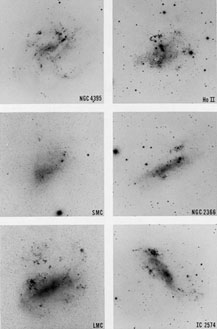


5.6 Sdm, Sm, and Im
These late-type galaxies form an important extension. Most such systems were called Irr by Hubble and Irr I by Holmberg, but they clearly follow naturally beyond the SAd and SBd forms. For example, Hodge and Hitchcock (1966) showed that galaxies of this type are highly flattened as a class (as in the earlier spirals), extending earlier work by de Vaucouleurs (1955a, b) for the Magellanic Clouds themselves. Furthermore, many studies show that the LMC is in a state of regular rotation (cf. Feast, Thackeray, and Wesselink 1961; Feast 1964, 1968 with extensive references therein), again similar to the earlier-type more regular spirals. And finally, ill-defined, subtle, but definite spiral structure has been detected (Section 4.1) by de Vaucouleurs (1954, 1955a).

|
Plate 7. The late end of the sequence of classification showing the varieties of Magellanic Cloud-type systems, classified either as Sm or Im galaxies depending on the presence or absence of vague spiral arms. The plates of the SMC and LMC are by Henize using the Mount Wilson 10-inch refractor in South Africa. The other photographs are from Mount Wilson or Palomar reflector plates. |
Most galaxies of this type are of low surface brightness, and have much lower luminosity than earlier-type spirals (HMS 1956; van den Bergh 1959, 1960a; de Vaucouleurs 1963b). Van den Bergh (1960b) has discussed the Sm and Im, types and has produced a catalog (1959), including the dE group, from the Palomar Sky Survey prints. Representatives are illustrated in Plate 7 and in the Hubble Atlas (pp. 38-40).